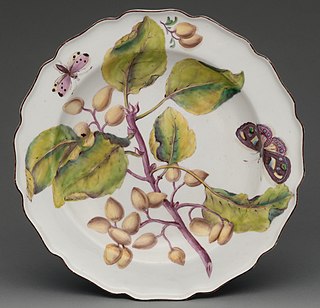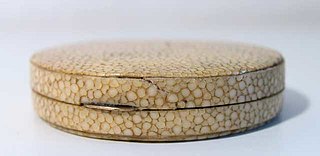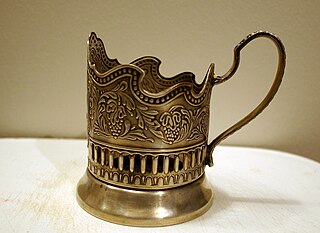
A spoon is a utensil consisting of a shallow bowl, oval or round, at the end of a handle. A type of cutlery, especially as part of a place setting, it is used primarily for transferring food to the mouth (eating). Spoons are also used in food preparation to measure, mix, stir and toss ingredients and for serving food. Present day spoons are made from metal, wood, porcelain or plastic. There are many different types of spoons made from different materials by different cultures for different purposes and food.

In cutlery or kitchenware, a fork is a utensil, now usually made of metal, whose long handle terminates in a head that branches into several narrow and often slightly curved tines with which one can spear foods either to hold them to cut with a knife or to lift them to the mouth.
Pewter is a malleable metal alloy consisting of tin (85–99%), antimony, copper (2%), bismuth, and sometimes silver. In the past it was an alloy of tin and lead, but most modern pewter, in order to prevent lead poisoning, is not made with lead. Pewter has a low melting point, around 170–230 °C (338–446 °F), depending on the exact mixture of metals. The word pewter is possibly a variation of "spelter", a term for zinc alloys.

The Japanese tea ceremony is a Japanese cultural activity involving the ceremonial preparation and presentation of matcha (抹茶), powdered green tea, the procedure of which is called temae (点前).

Scissors are hand-operated shearing tools. A pair of scissors consists of a pair of blades pivoted so that the sharpened edges slide against each other when the handles (bows) opposite to the pivot are closed. Scissors are used for cutting various thin materials, such as paper, cardboard, metal foil, cloth, rope, and wire. A large variety of scissors and shears all exist for specialized purposes. Hair-cutting shears and kitchen shears are functionally equivalent to scissors, but the larger implements tend to be called shears. Hair-cutting shears have specific blade angles ideal for cutting hair. Using the incorrect type of scissors to cut hair will result in increased damage or split ends, or both, by breaking the hair. Kitchen shears, also known as kitchen scissors, are intended for cutting and trimming foods such as meats.

Tableware items are the dishware and utensils used for setting a table, serving food, and dining. The term includes cutlery, glassware, serving dishes, serving utensils, and other items used for practical as well as decorative purposes. The quality, nature, variety and number of objects varies according to culture, religion, number of diners, cuisine and occasion. For example, Middle Eastern, Indian or Polynesian food culture and cuisine sometimes limits tableware to serving dishes, using bread or leaves as individual plates, and not infrequently without use of cutlery. Special occasions are usually reflected in higher quality tableware.

A tea party is a social gathering event held in the afternoon. For centuries, many societies have cherished drinking tea with companions at noon. Tea parties are considered for formal business meetings, social celebrations or just as an afternoon refreshment.

A plate is a broad, mainly flat vessel on which food can be served. A plate can also be used for ceremonial or decorative purposes. Most plates are circular, but they may be any shape, or made of any water-resistant material. Generally plates are raised round the edges, either by a curving up, or a wider lip or raised portion. Vessels with no lip, especially if they have a more rounded profile, are likely to be considered as bowls or dishes, as are very large vessels with a plate shape. Plates are dishware, and tableware. Plates in wood, pottery and metal go back into antiquity in many cultures.

A girandole is an ornamental branched candle holder consisting of several lights that may be on a stand or mounted on the wall, either by itself or attached to a mirror. Girandole has been used to refer to a number of different objects and designs; the early girandoles were candelabras decorated with crystals looking like a chandelier on a stand, and at one time it was also used to describe all candelabras and chandeliers, with or without crystals. Girandole first appeared in France in the mid-17th century as a luxurious appliance for lighting. In the 18-century, a girandole may be attached to a mirror, and large wall-mounted girandoles with a mirror incorporated became fashionable in England in the second half of the 18th century. A form of girandole backed with a round convex mirror was also popular in the United States in the early 19th century.

Shagreen is a type of rawhide consisting of rough untanned skin, historically from a horse's or onager's back, or from shark or ray.

A tea set or tea service is a collection of matching teaware and related utensils used in the preparation and serving of tea. The traditional components of a tea set may vary between societies and cultures.

The Classic of Tea or Tea Classic is the first known monograph on tea in the world, by Chinese writer Lu Yu between 760 CE and 762 CE, during the Tang dynasty. Lu Yu's original manuscript is lost; the earliest editions available date to the Ming dynasty.

A caddy spoon is a spoon used for measuring out tea in the form of dried tea leaves. Traditionally made of silver, they became very popular at the end of the 18th century, when this relatively inexpensive utensil could be found in practically any middle class household. Tea was sometimes stored in elaborate boxes or containers called tea caddies, and these spoons were made to be used with such containers. The caddy spoons went out of fashion in the early 20th century.

A sugar bowl is a small bowl designed for holding sugar or sugar cubes, to be served with tea or coffee in the Western tradition, that is an integral part of a tea set.

The podstakannik, or tea glass holder, is a holder with a handle, most commonly made of metal that holds a drinking glass (stakan). Their primary purpose is to be able to hold a very hot glass of tea, which is usually consumed right after it is brewed. The stability of the glass on the table is also significantly improved. It is a traditional way of serving and drinking tea in Russia, Ukraine, Belarus, and other Slavic states.

A salt spoon is a miniature utensil used with an open salt cellar for individual service. It is a historical and nostalgic item from a time before table salt was free-flowing, as it is today. The spoon itself ranges from 2 to 3 inches long and has a circular bowl measuring approximately 0.5 to 0.75 inches. They can be found in a wide range of materials including glass, Sterling silver, plastic, wood, ivory, bone and shell.
The lemon fork is a small serving utensil that is used to move lemon slices. Lemon forks have three long tines, with the outside tines splayed; ostensibly this arrangement helps to release more juice. Lemon forks became popular in the last quarter of the 19th century alongside other specialized utensils, such as asparagus tongs. One early 20th century cookbook called the lemon fork a "necessity" at the five o'clock tea party. While setting the table, the fork was placed over the slice of lemon. Unlike many specialized utensils of the 19th century, lemon forks are still used in the 21st century, primarily in restaurants.

The fish knife together with fish fork represent a set of utensils specialized for eating fish. Fish knife is a strange-looking, purposely blunt implement.

The fish fork, sometimes along with the fish knife, is an eating utensil specialized for fish meals. Like most highly specialized utensils, the fork dates back to Victorian era. With a length of about 7.5 inches, its distinctive features often include a wide left tine or a deep notch that can be fit over the bones. To avoid the metallic taste that comes from metal in the fork reacting with the acid in lemons, which are commonly served with fish, the fork was traditionally, until the arrival of stainless steel in the 1920s, made of silver.






















